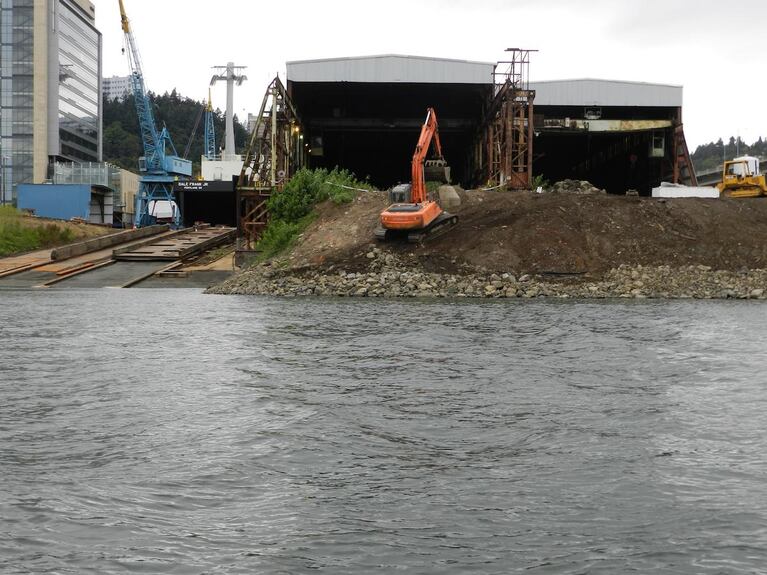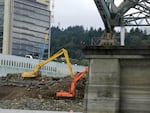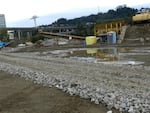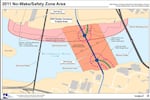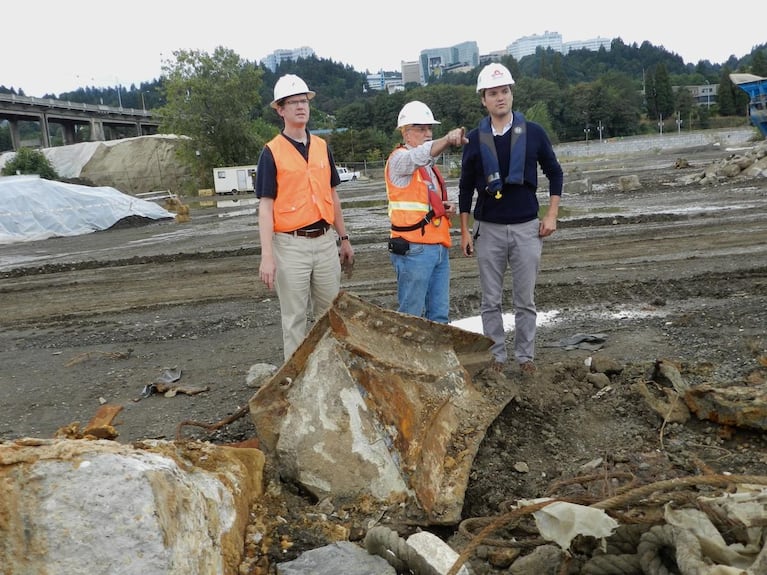
Erik Bakkom (left), Paul Fishman (center), and Matt French (right) discuss their work as they stand near parts of dismantled ships fished out of the Willamette River on the Zidell Waterfront cleanup site.
Bonnie Stewart
PORTLAND -- The Zidell Waterfront hazardous cleanup project should be complete by the end of October. That's the deadline for finishing in-water remediation because after that time, endangered salmon and steelhead trout become more plentiful in the Willamette River.
Making the river more fish friendly and the land a place people could live were goals behind the removal of more than a century of industrial hazardous waste at 1321 SW Moody Ave. The work created challenges that led to innovation.
Zidell Property History
Early 1900s: Commercial Iron Works built 200 ships for the U.S. Navy
1946: Zidell begins dismantling ships
1948: Zidell begins Tube Forging of America
1960: Zidell is nation's largest ship dismantler
1960: Zidell begins building barges
2011: Zidell continues to build barges
Visit the Zidell website for more detail and photos.http://www.zidell.com/story.html
"We were looking for the ability to haul soils contaminated with asbestos fibers up to the Wasco County landfill in the Dalles," said Erik Bakkom, an engineer with Maul Foster & Alongi. The problem had been the 6-foot drop from the truck bed to the ground. None of the available bags could survive the fall without breaking open.
The landfill operator, Dean Large, found a solution. Workers lined the large trucks with a high-density, woven polyethylene fabric used in road construction. Then the trucks were filled with contaminated soil and the fabric was sewn shut to prevent asbestos fibers from blowing out on the trip to the landfill. Pilot testing with jagged rocks showed that the big bag could survive the drop. Oregon's Department of Environmental Quality oversaw the work.
This is something Oregon's Department of Environmental Quality (DEQ) hadn't done before, nor had other landfills, Bakkom said. "That kind of collaboration has been going on all the way."
Hauling the soil in large loads also reduced the truck traffic through nearby neighborhoods, he said.
Another challenge was how to protect endangered fish from river sediment laced with metals, PCBs, petroleum hydrocarbons, polycyclic aromatic hydrocarbons and tributyltin, a biocide painted on ship hulls and docks to rid them of barnacles and mussels.
A plan to cap the sediment with limited dredging had to satisfy the DEQ and serve several interests, said ecologist Paul Fishman, project manager for the cleanup.The cap had to be:
thick enough to keep the pollution out of the water and protect fish
durable enough to withstand a 100-year flood and wave impacts
thin enough to allow Zidell to launch its barges and allow passage for vessels moving close to the shore.
For most of the work, the designers and the DEQ settled on a 2-foot layer of sand held in place with rocks. The large rocks, however, were too big to create an underwater habitat for the endangered fish. To satisfy the requirements of the National Oceanic and Atmospheric Administration fisheries section, Zidell is adding a layer of gravel, with its rocks no larger than 2 1/2 inches in diameter.
Cleanup By the Numbers
16 acres
2,700 linear feet of riverbank
3,000 linear feet of in-water cap
153,931 cubic yards of sand, rock armor, gravel and cap materials
2,200 treated wood pilings removed
Source: ZRZ Realty Company
Capping the sloping river bank and the barge launch area created a different dilemma. It required a thinner cap. The team considered putting sand into honeycomb materials or adding a clay layer covered with rock, Bakkom said.
"But what we ended up with was another geo-textile," he said.
They sandwiched activated carbon between two layers of a felt-like material, creating a blanket, Bakkom said.
"It's the same stuff that is in your water filters," he said. "The modeling on that shows that the fastest material moving through this would take 200 years."
The engineers also developed, and DEQ approved, a way to rid the site of some contaminated soil without trucking it to a landfill. They used it as fill for the TriMet transit station and bridge project on the adjoining property. They built a containment cell, added the soil and covered it with a geo-textile. TriMet is building containment walls around it and covering it with more fill. The roadway and lightrail station will be built on top of that, Fishman said.
Finally, 1,700 feet of riverbank had to be secured from erosion. For that, the team added fill and topsoil to create a gentler slope. That was topped with bundles of cut willows and straw, then hydro-seeded. Coir logs, made of coconut husk, add more bank protection. In the Spring, willows, dogwoods and other native trees and plants will be added, Fishman said.
The planning and cleanup haven't happened overnight. They took years, beginning with investigations and assessments by federal and state officials in the late 1980s. Zindell began its own studies in 1994 and entered a voluntary cleanup agreement with the state in 2006.
The work has gone smoothly, said Scott Manzano, DEQ's project manager for the cleanup. It was an example of real teamwork, he said.
The long-term plan for the property is some kind of development, said Matt French of ZRZ Realty Co., a Zindell family enterprise.
